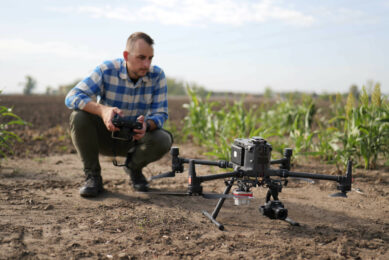Dutch province supports biodivers sowing with a drone

Dutch arable farmer Pim Clotscher had a green cover crop undersown at the end of June. After a trial last year on the farm, he now refers to it as a demonstration of what drone sowing can achieve. “I now see drone sowing as a promising method for undersowing cover crops. Here on the clay, but also in sandy areas.”
According to Clotscher, this is not necessarily tied to situations like this wet spring. Even under drier conditions, the drone offers opportunities. “With undersowing, you always have to weigh up the fact that for the seeds to establish well, you need to sow with enough soil moisture, while to avoid structural damage, it’s better to drive in dry conditions.”
Biodynamic farm
Clotscher is an arable farmer/tenant on the 106-hectare biodynamic farm Wilhelminahoeve in the Netherlands. The farm includes arable farming, beef cattle, and sheep. Additionally, he is an advisor/salesperson for organic seeds at a Dutch seed company. He also runs the organic contracting company Mechanisch Schoon, which focuses on organic maize cultivation. “My responsibility starts with plowing and ends when the maize is fully grown.”
Text continues below picture

Various types of seeds
Innovation and drone company Qlobel is taking care of the undersowing in summer triticale, summer barley, and summer wheat, all intended for seed multiplication. The mix being sown consists of crimson clover, Persian clover, and some phacelia, 18 kilograms of seed per hectare. Normally, Qlobel coats the seed with a clay coating to make it easier to spread. A trial is being conducted with some coated and some uncoated seed to investigate the differences. Later in July, this same mix will also be sown in pumpkins, as well as a clover mix in grassland.
“Last year, when it was much drier, we also undersown in seed multiplication of silage maize. That went well. It did lie dry for a while. I was a bit skeptical then. ‘Will it work out?’ I wondered. Yes, it did. So today, I don’t see it as an experiment, but more as a demonstration that it can be done, both over- and undersowing with the drone.”
Success depends on sufficient moisture

The great advantage of the drone is that it can sow at any time, even when it’s (too) wet for the tractor or the crop is already too high to drive through. A good example is overseeding clovers in grassland. Much of the success depends on the availability of sufficient moisture for the establishment of the young clover plants. A wet period can therefore be well utilized with drone sowing.
Clotscher receives compensation from the Dutch province of Zeeland. For the cost of the seed, it is €125 per hectare, and for sowing with the drone, it is €65 per hectare. The province of Zeeland supports the undersowing with the drone because the province wants to know if this method can contribute to increasing the fertility and biodiversity of the Zeeland fields. The drone rate varies depending on the area to be sown and whether or not the seed is coated (capacity) between €55 and €130 per hectare.
Preferably in May
Now, the clover/phacelia mix can start growing in the grain plots of the farm. The mix provides ground cover, nitrogen fixation, and good root development. After the grain harvest, Clotscher may mow the plots to clean up any weeds. The clover will then just keep growing.
“We are now quite close to the harvest; it would have been better to sow a bit earlier, for example, at the end of May. The undersowing would then have been more developed and had a greater weed-suppressing effect. On Tuesday, July 9, Clotscher reports that the sowing on June 29 has been successful. In the sense that the seed has germinated well. “The conditions were good. Great.”
Join 17,000+ subscribers
Subscribe to our newsletter to stay updated about all the need-to-know content in the agricultural sector, two times a week.



